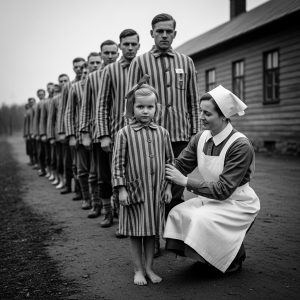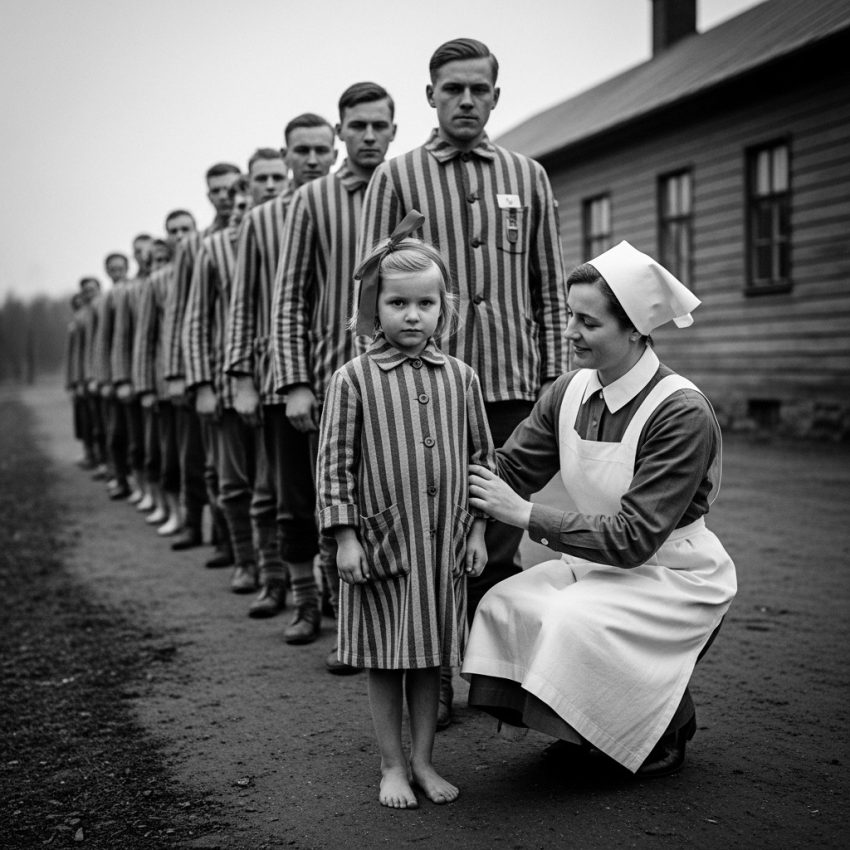When U.S. troops broke through the gates of Dachau concentration camp in April 1945, the air was thick with disbelief, death, and the faint sound of freedom. Soldiers who had fought their way across Europe stood stunned in front of what they saw: hundreds of skeleton survivors in ragged striped uniforms, with empty eyes and bodies that looked like they were barely alive.
There were many sad faces, but one small figure stood out. Not because of her power or height, but because of one small, rebellious thing: a bright red ribbon wrapped neatly into her hair.
She was probably no older than six or seven. Her small feet pressed against the freezing ground as she held onto the big hem of her concentration camp coat. She didn’t say anything when the soldiers came up to her and asked her name. Her lips shook, and she looked down at the ground. The barbed wire and smoke that still hung in the air seemed to have taken away her name, voice, and sense of belonging.
But she always tied the same red ribbon in her hair every morning.
It was a simple item that most people couldn’t see, but to her, it meant everything.

A THREAD OF HUMANITY IN A DARK WORLD
Days went by as doctors and nurses worked nonstop to help the survivors. Slowly and gradually, the things that are necessary for life came back: food, blankets, and medicine. But the troops saw that the girl didn’t say anything. She ate in silence. She slept with her back to the wall. But every morning, before the nurses came, she would reach into her pocket and knot the red ribbon again.
Lieutenant Margaret Hayes, an American nurse, started to notice the ritual. Hayes was a quiet woman from Illinois who had been taking care of survivors day and night. She knelt next to the girl one morning while she knotted her ribbon.
“Sweetheart,” she said softly, “why do you keep that ribbon?”
The youngster glanced up with worn, empty eyes and spoke for the first time since they saved her.
“So I remember that I’m a person.”
Those five words broke the silence like the sun breaking through a storm. In a place where names, faces, and hope were meant to be erased, this little girl, who had no name but was not lost, had kept her humanity with just a thread of scarlet.
THE NURSE WHO COULDN’T FORGET
After the war, the camp was cleared up, and the survivors were sent to shelters and orphanages all around Europe. The girl, who was still quiet and holding on to her ribbon, was sent to a children’s asylum in Switzerland.
Lieutenant Hayes assured herself that she would remember her before she went. She carefully took the ribbon out of the girl’s hair and kept it for a while.
“I’m going to keep this safe,” she added quietly. “Until you are ready to remember who you are.”
The girl nodded once and then left. She was just one of hundreds of children who had to leave their homes because of the conflict. Hayes looked for her for years but never found her again. She kept the ribbon with her for the duration of her duty, in her medical bag and between the pages of her journal.
It wasn’t just a memory for her. It was a sign of resistance, a reminder that even at the darkest times for people, a spark of identity could still live on.
FROM A HOSPITAL IN THE FIELD TO A MUSEUM GLASS CASE
Years went by. Hayes traveled back to the US, got married, and worked as a nurse in a tiny Boston hospital. She kept the red ribbon until she died in 1968. She asked that it be bequeathed to the United States Holocaust Memorial Museum in her will, along with a note she had written in precise handwriting:
“This ribbon belonged to a girl I met in Dachau. Every day she knotted it to remind herself that she was someone. “Please make sure the world remembers her.”
In 1971, the museum took the donation. The ribbon was meticulously restored and put behind glass. The ribbon was a small, fraying piece of silk that had endured both human cruelty and an indomitable spirit to survive.
The plaque says these words underneath it:
“The Red Ribbon of Dachau” was carried by a child whose name is not known. It serves as a symbol of remembrance and resistance.
People who come here generally stay longer than anywhere else. Some people cry softly. Some others stand quietly, contemplating how something so delicate, like a single ribbon, could hold the weight of faith, survival, and identity.
A STORY THAT LIVED THROUGH THE WAR
Decades later, historians discovered fragments of paperwork indicating the girl’s possible existence, adoption by a Swiss family, and eventual relocation to Canada. We don’t know her name, but a picture found in 1953 shows a woman with dark hair and a crimson ribbon wound around her wrist.
Was it her? There is no way to know for sure. But maybe the story’s power comes from the fact that it is a mystery.
The red ribbon now represents more than just one child. It belongs to everyone who has ever been told they are nothing and believed in themselves.
A THREAD THAT IS STRONGER THAN HATE
People still stop by the little display at the Holocaust Museum in Washington, D.C., today. The ribbon, which has faded and is fragile, lies under a beautiful beam of light. It is red against the white fabric below it.
Kids put their faces up against the glass. Teachers tell students what it means. Sometimes, survivors stop and say a prayer.
It isn’t gold or silver. It’s not a flag or a medal. It’s smaller but far more powerful.
A reminder that being who you are takes guts.
A sign that the desire to proclaim “I am someone” can never be taken away, even when all else is taken away, including freedom, family, and home.
LAST WORDS
Numbers often tell the most significant tragedies of history: millions dead, thousands lost, and countless forgotten. But sometimes, history is hidden in simple objects like a toy, a diary, or a ribbon.
The scarlet ribbon that the girl tied with shaking hands in the chilly wind of Dachau still speaks across time.
It tells us that stating “I am someone” and remembering who we are is the strongest way to fight back against a world that wants to erase us.
